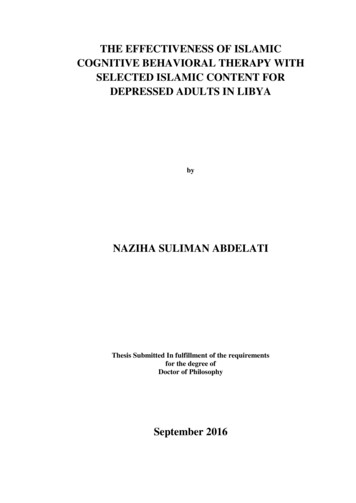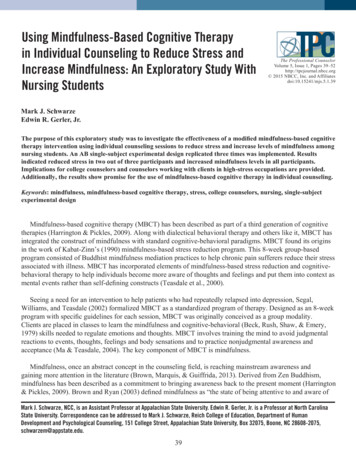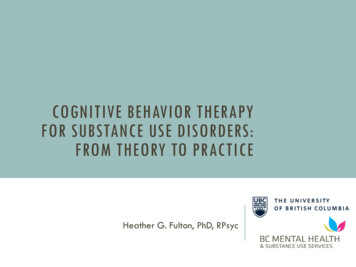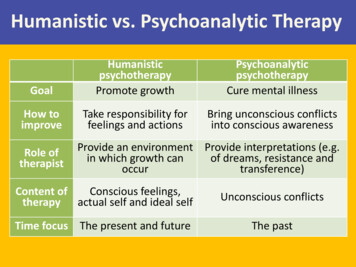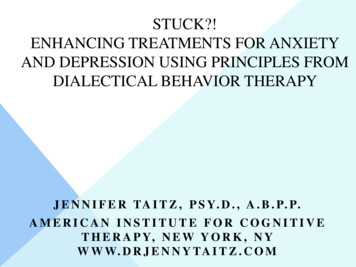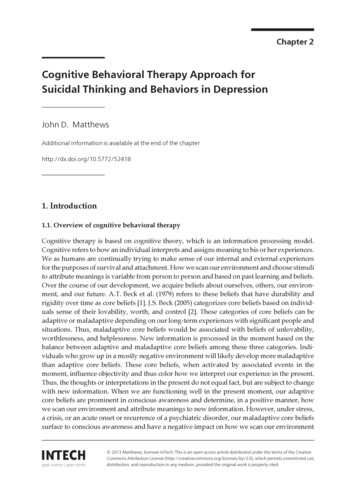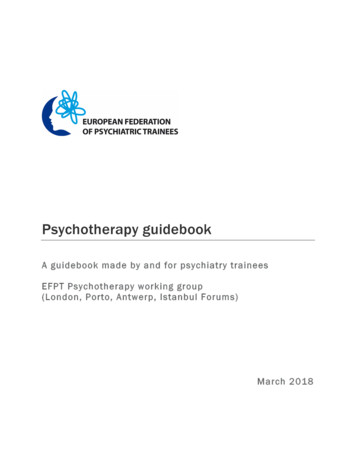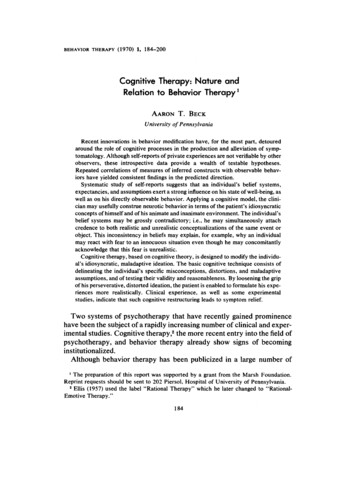
Transcription
BEHAVIOR THERAPY (1970) 1, 184-200Cognitive Therapy: Nature andRelation to Behavior Therapy 1AARON T. BECKUniversity of PennsylvaniaRecent innovations in behavior modification have, for the most part, detouredaround the role of cognitive processes in the production and alleviation of symptomatology. Although self-reports of private experiences are not verifiable by otherobservers, these introspective data provide a wealth of testable hypotheses.Repeated correlations of measures of inferred constructs with observable behaviors have yielded consistent findings in the predicted direction.Systematic study of self-reports suggests that an individual's belief systems,expectancies, and assumptions exert a strong influence on his state of well-being, aswell as on his directly observable behavior. Applying a cognitive model, the clinician may usefully construe neurotic behavior in terms of the patient's idiosyncraticconcepts of himself and of his animate and inanimate environment. The individual'sbelief systems may be grossly contradictory; i.e., he may simultaneously attachcredence to both realistic and unrealistic conceptualizations of the same event orobject. This inconsistency in beliefs may explain, for example, why an individualmay react with fear to an innocuous situation even though he may concomitantlyacknowledge that this fear is unrealistic.Cognitive therapy, based on cognitive theory, is designed to modify the individual's idiosyncratic, maladaptive ideation. The basic cognitive technique consists ofdelineating the individual's specific misconceptions, distortions, and maladaptiveassumptions, and of testing their validity and reasonableness. By loosening the gripof his perseverative, distorted ideation, the patient is enabled to formulate his experiences more realistically. Clinical experience, as well as some experimentalstudies, indicate that such cognitive restructuring leads to symptom relief.Two systems of psychotherapy that have recently gained prominencehave been the subject of a rapidly increasing number of clinical and experimental studies. Cognitive therapy, the more recent entry into the field ofpsychotherapy, and behavior therapy already show signs of becominginstitutionalized.Although behavior therapy has been publicized in a large number ofI The preparation of this report was supported by a grant from the Marsh Foundation.Reprint requests should be sent to 202 Piersol, Hospital of University of Pennsylvania.Ellis (1957) used the label "Rational Therapy" which he later changed to "RationalEmotive Therapy."184
COGNITIVE A N D BEHAVIOR THERAPY185articles and monographs, cognitive therapy has received much less recognition. Despite the fact that behavior therapy is based primarily on learning theory whereas cognitive therapy is rooted more in cognitive theory,the two systems of psychotherapy have much in common.First, in both systems of psychotherapy the therapeutic interview ismore overtly structured and the therapist more active than in other psychotherapies. After the preliminary diagnostic interviews in which a systematic and highly detailed description of the patient's problems isobtained, both the cognitive and the behavior therapists formulate thepatient's presenting symptoms (in cognitive or behavioral terms, respectively) and design specific sets of operations for the particular problemareas.After mapping out the areas for therapeutic work, the therapistexplicitly coaches the patient regarding the kinds of responses and behaviors that are useful with this particular form of therapy. Detailed instructions are presented to the patient, for example, to stimulate pictorial fantasies (systematic desensitization) or to facilitate his awareness andrecognition of his cognitions (cognitive therapy). The goals of thesetherapies are circumscribed, in contrast to the evocative therapies whosegoals are open ended (Frank, 1961).Second, both the cognitive and behavior therapists aim their therapeutic techniques at the overt symptom or behavior problem, such as a particular phobia, obsession, or hysterical symptom. However, the targetdiffers somewhat. The cognitive therapist focuses more on the ideationalcontent involved in the symptom, viz., the irrational inferences andpremises. The behavior therapist focuses more on the overt behavior,e.g., the maladaptive avoidance responses. Both psychotherapeuticsystems conceptualize symptom formation in terms of constructs that areaccessible either to behavioral observation or to introspection, in contrastto psychoanalysis, which views most symptoms as the disguised derivatives of unconscious conflicts.Third, in further contrast to psychoanalytic therapy, neither cognitivetherapy nor behavior therapy draws substantially on recollections orreconstructions of the patient's childhood experiences and early familyrelationships. The emphasis on correlating present problems with developmental events, furthermore, is much less prominent than in psychoanalytic psychotherapy.A fourth point in common between these two systems is that their theoretical paradigms exclude many traditional psychoanalytic assumptionssuch as infantile sexuality, fixations, the unconscious, and mechanisms ofdefense. The behavior and cognitive therapists may devise their ther-
186AARON T. BECKapeutic strategies on the basis of introspective data provided by thepatient; however, they generally take the patients' self-reports at facevalue 3 and do not make the kind of high-level abstractions characteristicof psychoanalytic formulations.Finally, a major assumption of both cognitive therapy and behaviortherapy is that the patient has acquired maladaptive reaction patterns thatcan be "unlearned" without the absolute requirement that he obtaininsight into the origin of the symptom.One of the major assets of behavior therapy has been the large numberof well-designed experiments that support certain of its basic assumptions. Although of more recent vintage, several systematic studies supporting the underpinnings of cognitive therapy have also been reported(Carlson, Travers, & Schwab, 1969; Jones, 1968; Krippner, 1964; Loeb,Beck, Diggory, & Tuthill, 1967; Rimm & Litvak, 1969; Velten, 1968).The few controlled-outcome studies of cognitive therapy (Ellis, 1957;Trexler & Karst, 1969) provide preliminary evidence of the effectivenessof this therapy.There are obvious differences in the techniques used in behaviortherapy and cognitive therapy. In systematic desensitization, for example,the behavior therapist induces a predetermined sequence of pictorialimages alternating with periods of relaxation. The cognitive therapist, onthe other hand, relies more on the patient's spontaneously experiencedand reported thoughts. These cognitions, whether in pictorial or verbalform, are the target for therapeutic work. The technical distinctionsbetween the two systems of psychotherapy are often blurred, however.For example, the cognitive therapist uses induced images to clarifyproblems (Beck, 1967; 1970), and the behavior therapist uses verbal techniques such as "thought-stoppage" (Wolpe & Lazarus, 1966).The most striking theoretical difference between cognitive and behavior therapy lies in the concepts used to explain the dissolution of maladaprive responses through therapy. Wolpe, for example, utilizes behavioral orneurophysiological explanations such as counterconditioning or reciprocal inhibition; the cognitivists postulate the modification of conceptualsystems, i.e., changes in attitudes or modes of thinking. As will be discussed later, many behavior therapists implicitly or explicitly recognizethe importance of cognitive factors in therapy, although they do notexpand on these in detail (Davison, 1968; Lazarus, 1968).Although the patient may not be immediatelyaware of the content of his maladaptiveattitudes and patterns, this concept is not "unconscious" in the psychoanalytic sense and isaccessibleto the patient's introspection. Furthermore, unlike manypsychoanalyticformulations, the inferences can be tested by currently available research techniques.
COGNITIVE AND BEHAVIOR THERAPY187TECHNIQUES OF COGNITIVE THERAPYCognitive therapy may be defined in two ways: In a broad sense, anytechnique whose major mode of action is the modification of faulty patterns of thinking can be regarded as cognitive therapy. This definitionembraces all therapeutic operations that indirectly affect the cognitivepatterns, as well as those that directly affect them (Frank, 1961). An individual's distorted views of himself and his world, for example, may becorrected through insight into the historical antecedents of his misinterpretations (as in dynamic psychotherapy), through greater congruencebetween the concept of the self and the ideal (as in Rogerian therapy), andthrough increasingly sharp recognition of the unreality of fears (as in systematic desensitization).However, cognitive therapy may be defined more narrowly as a set ofoperations focused on a patient's cognitions (verbal or pictorial) and onthe premises, assumptions, and attitudes underlying these cognitions.This section will describe the specific techniques of cognitive therapy.Recognizing Idiosyncratic CognitionsOne of the main cognitive techniques consists of training the patient torecognize his idiosyncratic cognitions or "automatic thoughts" (Beck,1963). Ellis (1962)refers to these cognitions as "internalized statements"or "self-statements," and explains them to the patient as "things that youtell yourself." These cognitions are termed idiosyncratic because theyreflect a faulty apparisal, ranging from a mild distortion to a completemisinterpretation, and because they fall into a pattern that is peculiar to agiven individual or to a particular psychopathological state.In the acutely disturbed patient, the distorted ideation is frequently inthe center of the patient's phenomenal field. In such cases, the patient isvery much aware of these idiosyncratic thoughts and can easily describethem. The acutely paranoid patient, for instance, is bombarded withthoughts relevant to his being persecuted, abused, or discriminatedagainst by other people. In the mild or moderate neurotic, the distortedideas are generally at the periphery of awareness. 4 It is therefore necessary to motivate and to train the patient to attend to these thoughts.Many patients reporting unpleasant affects describe a sequence consisting of a specific event (external stimulus) leading to an unpleasant affect.For instance, the patient may outline the sequence of (a) seeing an oldfriend and then (b) experiencing a feeling of sadness. Oftentimes, the4 In obsessionalneurosis,of course, the idiosyncraticideas are centraland the patient hasdifficultyin ignoringthem.
188AARON T. BECKsadness is inexplicable to the patient. Another person (a) hears aboutsomebody having been killed in an automobile accident and (b) feelsanxiety. However, he cannot make a direct connection between these twophenomena; e.g., there is a missing link in the sequence.In these instances of a particular event leading to an unpleasant affect,it is possible to discern an intervening variable, namely, a cognition,which forms the bridge between the external stimulus and the subjectivefeeling. Seeing an old friend stimulates cognitions such as "It won't belike old times," or " H e won't accept me as he used to." The cognitionthen generates the sadness. The report of an automobile accident stimulates a pictorial image in which the patient himself is the victim of anautomobile accident. The image then leads to the anxiety.This paradigm can be further illustrated by a number of examples. Apatient treated by the writer complained that he experienced anxietywhenever he saw a dog. 5 He was puzzled by the fact that he experiencedanxiety even when the dog was chained or caged or else was obviouslyharmless. The patient was instructed: "Notice what thoughts go throughyour mind the next time you see a dog--any dog." At the next interview,the patient reported that during numerous encounters with dogs betweenappointments, he had recognized a phenomenon that he had not noticedpreviously; namely, that each time he saw the dog he had a thought suchas "It's going to bite me."By being able to detect the intervening cognitions, the patient was ableto understand why he felt anxious, namely, he indiscriminately regardedevery dog as dangerous. He stated, "I even got that thought when I saw asmall poodle. Then I realized how ridiculous it was to think that a poodlecould hurt me." He also recognized that when he saw a big dog on a leash,he thought of the most deleterious consequences: "The dog will jump upand bite out one of my eyes," or "It will jump up and bite my jugular veinand kill me." Within 2 or 3 weeks, the patient was able to overcome completely his long-standing dog phobia simply by recognizing his cognitionswhen exposed to a dog.Another example was provided by a college student who experiencedinexplicable anxiety in a social situation. After being trained to examineand write down his cognitions, he reported that in social situations hewould have thoughts such as, "They think I look pathetic," or "Nobodywill want to talk to me," or "I'm just a misfit." These thoughts werefollowed by anxiety.s Ellis (1962) described a similarcase.
COGNITIVE AND BEHAVIOR THERAPY189A patient complained that he was chronically angry at practically everybody whom he saw, but could not account for his angry response tothese people. After some training at recognizing his cognitions, hereported having such thoughts as "He's pushing me around," " H e thinksI'm a pushover," "He's trying to take advantage of me." Immediatelyafter experiencing these thoughts, he would feel angry at the individualtowards whom they were directed. He also realized that there was no realistic basis for his appraising people in this negative way.Sometimes, the cognition may take a pictorial form instead of, or inaddition to, the verbal form (Beck, 1970). A woman who experiencedspurts of anxiety when riding across a bridge was able to recognize thatthe anxiety was preceded by a pictorial image of her car breaking throughthe guard rail and falling off the bridge. Another woman, with a fear ofwalking alone, found that her spells of anxiety followed images of herhaving a heart attack and being left helpless and dying on the street. Acollege student discovered that his anxiety at leaving his dormitory atnight was triggered by visual fantasies of being attacked.The idiosyncratic cognitions (whether pictorial or verbal) are very rapidand often may contain an elaborate idea compressed into a very shortperiod of time, even into a split second. These cognitions are experiencedas though they are automatic; i.e., they seem to arise as if by reflex ratherthan through reasoning or deliberation. They also seem to have an involuntary quality. A severely anxious or depressed or paranoid person, forexample, may continually experience the idiosyncratic cognitions, eventhough he may try to ward them off. Furthermore, these cognitions tendto appear completely plausible to the patient.DistancingEven after a patient has learned to identify his idiosyncratic ideas, hemay have difficulty in examining these ideas objectively. The thoughtoften has the same kind of salience as the perception of an external stimulus. "Distancing" refers to the process of gaining objectivity towardsthese cognitions. Since the individual with a neurosis tends to accept thevalidity of his idiosyncratic thoughts without subjecting them to any kindof critical evaluation, it is essential to train him to make a distinctionbetween thought and external reality, between hypothesis and fact.Patients are often surprised to discover that they have been equating aninference with reality and that they have attached a high degree of truthvalue to their distorted concepts.The therapeutic dictum communicated to the patient is as follows:
190A A R O N T. B EC KSimply because he thinks something does not necessarily mean that it istrue. While such a dictum may seem to be a platitude, the writer has foundwith surprising regularity that patients have benefited from the repeatedreminder that thoughts are not equivalent to external reality.Once the patient is able to "objectify" his thoughts, he is ready for thelater stages of reality testing: applying rules of evidence and logic andconsidering alternative explanations.Correcting Cognitive Distortions and DeficienciesThe writer has already indicated that patients show faulty or disorderedthinking in certain circumscribed areas of experience. In these particularsectors, they have a reduced ability to make fine discriminations and tendto make global, undifferentiated judgments. Part of the task of cognitivetherapy is to help the patient to recognize faulty thinking and to make appropriate corrections. It is often very useful for the patient to specify thekind of fallacious thinking involved in his cognitive responses.Arbitrary inference refers to the process of drawing a conclusion whenevidence is lacking or is actually contrary to the conclusion. This type ofdeviant thinking usually takes the form of personalization (or selfreference). A depressed patient, who saw a frown on the face of a passerby, thought, " H e is disgusted with me." A phobic girl of 21, readingabout a woman who had had a heart attack, got the thought, "I probablyhave heart disease." A depressed woman, who was kept waiting for a fewminutes by the therapist, thought, " H e has deliberately left in order toavoid seeing me,"Overgeneralization refers to the process of making an unjustified generalization on the basis of a single incident. This may take the form that wasdescribed in the case of the man with the dog phobia, who generalizedfrom a particular dog that might attack him to all dogs. Another exampleis a patient who thinks, "I never succeed at anything" when he has asingle isolated failure.Magnification refers to the propensity to exaggerate the meaning orsignificance of a particular event. A person with a fear of dying, forinstance, interpreted every unpleasant sensation or pain in his body as asign of some fatal disease such as cancer, heart attack, or cerebral hemorrhage. Ellis (1962) applied the label "castrophizing" to this kind ofreaction.As noted above, it is often helpful for the patient to label the particularaberration involved in his maladaptive cognition. Once the patient has
COGNITIVE AND BEHAVIOR THERAPY191firmly established that a particular type of cognition, such as "That dog isgoing to bite me," is invalid, he will be equipped to correct this cognitionon subsequent occasions. For example, his planned, rational response tothe stimulus of a toy poodle would be, "Actually, it is just a harmlesspoodle and there is only a remote chance that it would bite me. And evenif it did, it could not really injure me."Cognitive deficiency refers to the disregard for an important aspect of alife situation. Patients with this defect ignore, fail to integrate, or do notutilize information derived from experience. Such a patient, consequently, behaves as though he has a defect in his system of expectations:He consistently engages in behavior which he realizes, in retrospect, isself-defeating. This class of patients includes those who "act out," e.g.,psychopaths, as well as those whose overt behavior sabotages importantpersonal goals. These individuals sacrifice long-range satisfaction orexpose themselves to later pain or danger in favor of immediate satisfactions. This category includes problems such as alcoholism, obesity, drugaddition, sexual deviation, and compulsion gambling.The deficient-anticipation patients show two major characteristics:First, when they yield to their wishes to engage in self-defeating, dangerous, or antisocial activities, they are oblivious of the probableconsequences of their actions. At these times, they avoid thinking aboutthe consequences by concentrating only on the present activity. Theymay fortify this modus operandi through an elaborate system of selfdeceptions, such as "It can't do any harm to cut loose, now." Secondly,irrespective of how often the individual is "burned" as a result of hismaladaptive actions, he does not seem to integrate knowledge of thecause-and-effect relationships into his behavior.Therapy of such cases consists of training the patient to think of theconsequences as soon as his self-defeating wish arises. Consideration ofthe long-range loss must be forced into the interval between impulse andaction. A patient, for instance, who continually operated his car beyondthe speed limit or drove through stoplights was surprised each time hewas stopped by a traffic officer. On interview, it was discovered that thepatient was generally absorbed in a fantasy while driving--he imagedhimself as a famous racing-car driver engaged in a race. Therapy at firstconsisted of trying to get him to watch the odometer--but withoutsuccess. The next approach consisted of inducing fantasies of speeding,getting caught, and receiving punishment. At first, the patient had greatdifficulty in visualizing getting caught even though, in general, he couldfantasize almost everything. However, after several sessions of induced
192AARON T. BECKfantasies, he was able to incorporate a negative outcome into his fantasy.Subsequently, he stopped daydreaming while driving and was able toobserve traffic regulations.In the following case report, several cognitive techniquesmodifying anxiety pronenessdirected atare illustrated.CASE REPORT Mrs. G. was an attractive 2?-year-old mother of three children. When first seen by thewriter, she complained of periods of anxiety lasting up to 6 or 7 hr a day and recurringrepeatedly over a 4-year period. She had consulted her family physician, who had prescribeda variety of sedatives, including Thorazine, without any apparent improvement.In an analysis of the cause-and-effect sequence of her anxiety, the following facts wereelicited. The first anxiety episode occurred about 2 weeks after she had had a miscarriage.At that time she was bending over to bathe her 1-year-old son, and she suddenly began tofeel faint. Following this episode, she had her first anxiety attack which lasted several hours.The patient could not find any explanation for her anxiety. However, when the writer askedwhether she had had any thought at the time she felt dizzy, she recalled having had thethought, "Suppose I should pass out and injure the baby." It seemed plausible that her dizziness, which was probably the result of a postpartum anemia, led to the fear she might faintand drop the baby. This fear then produced anxiety, which she interpreted as a sign that shewas "going to pieces."Until the time of her miscarriage, the patient had been reasonably carefree and had not experienced any episodes of anxiety. However, after her miscarriage, she periodically had thethought, "Bad things can happen to me." Subsequently, when she heard of somebody'sbecoming sick, she often would have the thought, "This can happen to me," and she wouldbegin to feel anxious.The patient was instructed to try to pinpoint any thoughts that preceded further episodesof anxiety. At the next interview, she reported the following events:1. One evening, she heard that the husband of one of her friends was sick with a severepulmonary infection. She then had an anxiety attack lasting several hours. In accordancewith the instructions, she tried to recall the preceding cognition, which was, "Tom could getsick like that and maybe die."2. She had considerable anxiety just before starting a trip to her sister's house. Shefocused on her thoughts and realized she had the repetitive thought that she might get sickon the trip. She had had a serious episode of gastroenteritis during a previous trip to hersister's house. She evidently believed that such a sickness could happen to her again.3. On another occasion, she was feeling uneasy and objects seemed somewhat unreal toher. She then had the thought that she might be losing her mind and immediately experienced an anxiety attack.4. One of her friends was committed to a state hospital because of a psychiatric illness.The patient had the thought, "This could happen to me. I could lose my mind." When questioned about why she was afraid of losing her mind, she stated that she was afraid that if shewent crazy, she would do something that would harm either her children or herself.It was evident that the patient's crucial fear was the anticipation of loss of control,whether by fainting or by becoming psychotic. The patient was reassured that there were no6 This patient was treated in collaboration with Dr. William Dyson.
COGNITIVE AND BEHAVIOR THERAPY193signs that she was going psychotic. She was also provided with an explanation of the arousalof her anxiety and of her secondary elaboration of the meaning of these attacks.The major therapeutic thrust in this case was coaching the patient to recall and reflect onthe thoughts that preceded her anxiety attacks. The realization that these attacks wereinitiated by a cognition rather than by some vague mysterious force convinced her she wasneither totally vulnerable nor unable to control her reactions. Furthermore, by learning topinpoint the anxiety-reducing thoughts, she was able to gain some detachment and to subjectthem to reality testing. Consequently, she was able to nullify the effects of those thoughts.During the next few weeks, her anxiety attacks became less frequent and less intense and,by the end of 4 weeks, they disappeared completely.DIFFERENCES IN CONCEPTUAL FRAMEWORK BETWEENBEHAVIOR THERAPY AND COGNITIVE THERAPYBehavior therapists conceptualize disorders of behavior and procedures for their amelioration within a theoretical f r a m e w o r k borrowedfrom the field of psychological learning theory and especially by means ofconcepts of classical and operant conditioning. Since these concepts arederived mainly from experiments with animals, they focus on the observable b e h a v i o r of the organism. In fact, m o s t of the published writings onbehavior therapy tend to eschew inferred or hypothesized psychologicalstates which cannot be directly o b s e r v e d and measured. C o n c e p t s andprinciples based on immediate referents in the organism's environmenthave advantages of parsimony, testability, quantifiability, and reliability.H o w e v e r , this f r a m e w o r k does not readily a c c o m m o d a t e notions of internal psychological states such as thoughts, attitudes, and the like, whichwe c o m m o n l y use to understand ourselves and other people. Cognitivetherapists are more willing to use these inferred psychological states, collectively called "cognitions," as clinical data. Consequently, large anduseful sets of variables are directly taken into account.In recent years, several writers in the area of behavior therapy have acknowledged the importance of mediational constructs or cognitiveprocesses in behavior therapy (Brady, 1967; Davison, 1968; Folkins,Lawson, Opton, & Lazarus, 1968; Lazarus, 1968; Leitenberg, Agras,Barlow, & Oliveau, 1969; London, 1964; Mischel, 1968; Murray &Jacobson, 1969; Sloane, 1969; Valine & Ray, 1967; Weitzman, 1967).Their cognitive formulations, however, have for the most part been brief.Substantial amplification of the nature of cognitive processes is necessaryto account adequately for clinical p h e n o m e n a and for the effects of therapeutic intervention (see Weitzman, 1967).A greater emphasis on the individual's descriptions of internal eventscan lead to a more complete view of human p s y c h o p a t h o l o g y and themechanisms of behavioral change. By using introspective data, the cogni-
194A A R O N T. B E C Ktive theorist has access to the patient's thoughts, ideas, attitudes, dreams,and daydreams. These ideational productions provide the cognitivetheorist with the raw materials with which he can form concepts andmodels. Such concepts are also capable of generating hypotheses amenable to controlled experiments on psychiatric patients (Loeb et al., 1967).Also, introspective data, such as dreams and cognitions, have beenadapted to systematic investigation (Beck, 1967).Study and analysis of the introspective data suggest that the cognitiveorganization, far from being a mere link in the stimulus response chain, isa quasi-autonomous system in its own right. Although this system generally interacts with the environment to a large extent, it may at other timesbe relatively independent of the environment; for example, when thepatient is daydreaming or in the grip of an abnormal state such as depression.By getting inside the psychological matrix, as it were, the cognitivetheorist gains a glimpse of considerable activity. Introspective dataindicate the existence of complex organizations of cognitive structuresinvolved in the processes of screening external stimuli, interpreting experiences, storing and selectively recalling memories, and setting goals andplans (Harvey, Hunt & Schroder, 1961). Data suggest that cognitive organizations are highly active and are much more than a simple conduitbetween stimulus and response.A COGNITIVE MODEL OF PSYCHOPATHOLOGYThe total cognitive organization appears to be composed of primitivesystems consisting of relatively crude cognitive structures (correspondingto Freud's notion of Primary Process), and of more mature systems composed of refined and elastic structures (corresponding to the SecondaryProcess). Some of the conceptual elements may be predominantly verbal,whereas others may be predominantly pictorial.Many of the primitive concepts are idiosyncratic and unrealistic. Underordinary waking conditions, these idiosyncratic concepts appear to exertonly minimal or sporadic effects on the integrated thinking of the individual. Peculiar or irrational cognitions emanating fr
The few controlled-outcome studies of cognitive therapy (Ellis, 1957; Trexler & Karst, 1969) provide preliminary evidence of the effectiveness of this therapy. There are obvious differences in the techniques used in behavior therapy and cognitive therapy. In systematic desensitization, for example,
